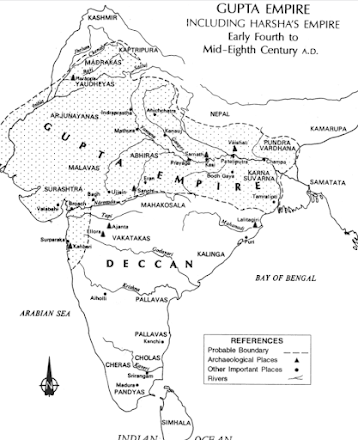The Gupta Dynasty
The Gupta Dynasty
(4th century CE to 6th century CE)
-the Dynasty that gifted Aryabhata and Kalidas
Introduction:
The Guptas ruled the Magadha state in north-eastern region of India. The
Magadha region is presently located in Bihar, India. They maintained their
dominance over the northern and certain parts of central and western India.
This dynasty is regarded as India’s one of the most culturally rich provinces.
The rule extended from early 4th century CE to late 6th
century CE.
The Gupta dynasty originated as a wealthy family from either Magadha or
Prayaga .The family rose to claiming the local dominance over the Magadha province.
Over the years, the succeeding rulers expanded the dynasty both culturally and
territory-wise.
Image reference- https://upload.wikimedia.org/wikipedia/commons/c/ca/The_Gupta_Empire.gif
The rise and fall of the Guptas-
The empire name “The Guptas” is simply derived from
the family surname. The local dominance over Magadha was transformed to a
dynasty by the third Gupta king, Chandra Gupta I, in around 320 AD. He is
regarded as the first ruler of the Gupta Empire. Chandra Gupta I united the
Guptas with the Licchavis by marriage. He expanded the rule over the
surrounding regions either by militaristic expansion or by means of marriage
alliances.
A gold coin depicting Queen Kumaradevi and King
Chandragupta I.
Image reference-https://en.wikipedia.org/wiki/Chandragupta_I#/media/File:Queen_Kumaradevi_and_King_Chandragupta_I_on_a_coin.jpg
The celebrated Samudra Gupta, son of Chandra Gupta I,
was appointed as the next ruler by 330 AD. He recognized the city of
Pataliputra as the capital of the dynasty. By 380 AD, the empire had expanded up
to Myanmar in the east, territories north to the Himalayas including Nepal and
the entire western Indus Valley region. During this period, Guptas allowed the
defeated rulers to continue to rule their respective territories as tributary
states.
Coin of the Gupta king Samudragupta.
Image reference-https://en.wikipedia.org/wiki/Samudragupta#/media/File:SamudraguptaCoin.jpg
The third ruler of the empire, Chandra Gupta II, was renowned for extending the rule up to Ujjain. He was also known “Vikramaditya” (Son of valor).His reign was recognized for major cultural and intellectual developments than military achievements.
Coin of the Gupta king Chandragupta II
Image reference-https://en.wikipedia.org/wiki/Chandragupta_II#/media/File:ChandraguptaIIOnHorse.jpg
The successors after this period witnessed the gradual
demise of the dynasty including Kumara Gupta, Skanda Gupta, and others. The
major downfall of the empire occurred after the invasions of Hunas. They were known
to Byzantine sources, a branch of Hephthalites.
By the end of the 6th century the dynasty
almost came to an end, shrinking to a small local territory.
Significance and contribution of the Gupta dynasty-
A peculiarity of the Gupta dynasty was that it practiced decentralized system of authority. Certain officers or family members
were appointed to govern the small units of provinces called as pradeshas or
vishayas.
The Gupta period was recognized as the classical age
of India. But this has been challenged by the extensive studies and research
between the Mauryan and Gupta periods. Certain historians regarded Gupta period
as the origin for the decimal system of notation, the great Sanskrit scripts,
as well as contributions in the fields of astronomy, mathematics, metallurgy,
art, culture, etc.
Fa Xian, a Chinese Buddhist, visited the Gupta India during the rule of Chandra Gupta II. He described the dynasty as a prosperous rule with beautiful cities, fine hospitals and universities.
Under the Guptas, Hinduism saw a rise of interest.
It is believed that, during the reign of Chandra Gupta
II, art, culture, architecture and sculptural developments reached the peak
and declined to the climax with it. Chandra Gupta II patronized learning among
the scholars in his court, which included the astronomer Varahamihira and the
Sanskrit poet and dramatist Kalidasa.
Dashavatara Temple is a Vishnu Hindu temple built
during the Gupta period.
Image reference-https://en.wikipedia.org/wiki/Gupta_Empire#/media/File:Deogarh01.jpg
Eventually quoting the lines of Sita Ram Goel from one of his books,
“The Gupta Age was in fact the golden age of Hindu history when Hindu spirituality, art, literature, science, and philosophy attained an acme which has not since been surpassed. Every nation has glorified one period or the other of its past history.... A period of greatness in which a people can take pride, provides a point of self-identification to that people. The soul of a nation is nourished by legitimate pride in a period when its creativity attained a pinnacle".
-By Samruddhi Kamthe (SY Computer)
References:
https://www.indiatoday.in/education-today/gk-current-affairs/story/facts-on-gupta-empire-the-dynasty-that-gave-us-kalidas-and-aryabhata-1594951-2019-09-03
https://en.wikipedia.org/wiki/Gupta_Empire
https://www.britannica.com/topic/Gupta-dynasty
Image References:
I, PHGCOM, CC BY-SA 3.0 <http://creativecommons.org/licenses/by-sa/3.0/>, via Wikimedia Commons
RNRCTG, CC BY-SA 4.0 <https://creativecommons.org/licenses/by-sa/4.0>, via Wikimedia Commons
byron aihara, CC BY-SA 2.0 <https://creativecommons.org/licenses/by-sa/2.0>, via Wikimedia Commons
Uploadalt, CC BY-SA 3.0 <https://creativecommons.org/licenses/by-sa/3.0>, via Wikimedia Commons
I, PHGCOM, CC BY-SA 3.0 <http://creativecommons.org/licenses/by-sa/3.0/>, via Wikimedia Commons
NOTE :-
This blog is meant for Educational Purpose only .We do not own any Copyrights related to images and information , all the rights goes to their respective owners . The soul purpose of this blog is to Educate, Inspire, Empower and to create awareness in the viewers. The usage is non-commercial(Not For Profit) and we do not make any money from it.
FOLLOW US ON:-
INSTAGRAM :
https://bit.ly/coep_blogs_insta
LINKEDIN:
https://bit.ly/coep_blogs_linkedIn
YOUTUBE:-
https://bit.ly/Coep_blogs_YouTube








Comments
Post a Comment